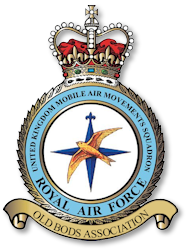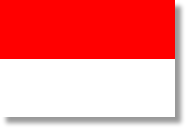

The 2004 Indian Ocean earthquake was an undersea earthquake that occurred at 00:58:53 UTC December 26, 2004, with an epicentre off the west coast of Sumatra, Indonesia. The earthquake triggered a series of devastating tsunami along the coasts of most landmasses bordering the Indian Ocean, killing more than 225,000 people in eleven countries, and inundating coastal communities with waves up to 30 meters (100 feet). It was one of the deadliest natural disasters in history. Indonesia, Sri Lanka, India, and Thailand were hardest hit.
With a magnitude of between 9.1 and 9.3, it is the second largest earthquake ever recorded on a seismograph. This earthquake had the longest duration of faulting ever observed, between 8.3 and 10 minutes. It caused the entire planet to vibrate as much as 1 cm (0.5 inches) and triggered other earthquakes as far away as Alaska.
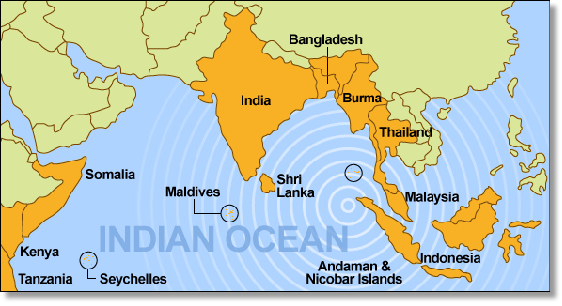
The deaths and destruction caused by the earthquake and tsunami triggered a massive, worldwide wave of generosity and more than $10 billion in financial aid. The funds have come from countries, businesses, and individuals.
Planning staff from both HQ Strike Command and the Brize Norton-based air transport operations cell had holidays cut short as they planned the movement of crews, freight and passengers around the globe to ensure the swift delivery of resources where required.
Shortly after 0700 on New Year’s day 2005, the first of the RAF flights commenced as a Lyneham Hercules captained by Flight Lieutenant Scott Bateman was despatched to Gardemoen Airport in Oslo. The crew's mission was to pick and pre-position, in Denmark, an assortment of emergency supplies and equipment donated by the international Humanitarian Partnership whose member countries include Denmark, Sweden, Norway and Finland. The load also included equipment donated by the United Kingdom and Netherlands.
En route to Norway, a 4-person UK Mobile Air Movements Squadron (MAMS) team from RAF Lyneham and 3-person JATEU team from Brize Norton were dropped off at Billund airport in Denmark to co-ordinate and prepare loads for onward movement to Banda Aceh. In addition, a 4-man UK MAMS team headed up by Sgt Dave Wilson continued to Gardemon to prepare Hercules loads destined for Denmark and a Tristar KC1 load destined for Penang. Through snow showers and temperatures of minus 12 degrees, they worked to ensure that the load was prepared as quickly as possible. Sgt Dave Wilson said, "Working outside in these extremes of temperature was a real challenge but is something that UKMAMS personnel get used to. Knowing that it was for such an important task gave all of the team the added incentive to get the job done."
Shortly after 0700 on New Year’s day 2005, the first of the RAF flights commenced as a Lyneham Hercules captained by Flight Lieutenant Scott Bateman was despatched to Gardemoen Airport in Oslo. The crew's mission was to pick and pre-position, in Denmark, an assortment of emergency supplies and equipment donated by the international Humanitarian Partnership whose member countries include Denmark, Sweden, Norway and Finland. The load also included equipment donated by the United Kingdom and Netherlands.
En route to Norway, a 4-person UK Mobile Air Movements Squadron (MAMS) team from RAF Lyneham and 3-person JATEU team from Brize Norton were dropped off at Billund airport in Denmark to co-ordinate and prepare loads for onward movement to Banda Aceh. In addition, a 4-man UK MAMS team headed up by Sgt Dave Wilson continued to Gardemon to prepare Hercules loads destined for Denmark and a Tristar KC1 load destined for Penang. Through snow showers and temperatures of minus 12 degrees, they worked to ensure that the load was prepared as quickly as possible. Sgt Dave Wilson said, "Working outside in these extremes of temperature was a real challenge but is something that UKMAMS personnel get used to. Knowing that it was for such an important task gave all of the team the added incentive to get the job done."
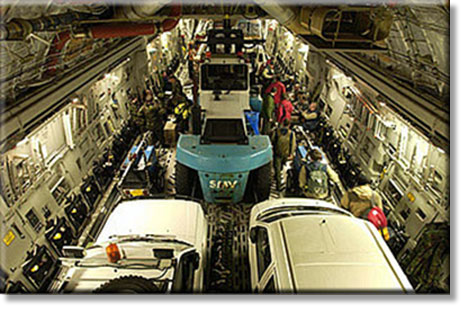
At 1300 the same day, I joined a 99 Squadron C-17 as it took off the civilian airport at Billund, which was acting as the distribution hub for equipment destined for use by United Nations personnel as part of their co-ordination and rescue effort.
During a two-hour loading operation, the UKMAMS team together with the aircrew loaded generators, vehicles, water purification and other vital equipment.
Such was the unusual nature of the load, which included a 22-ton forklift truck.
A Joint Air Transport Evaluation Unit (JATEU) team led by Flight Lieutenant Ruth Harris were on hand to offer specialist advice and guidance.
She said, "The weight and profile of the forklift tested the loading limitations of the aircraft and detailed calculations were required to enable it to be restrained safely and securely."
During a two-hour loading operation, the UKMAMS team together with the aircrew loaded generators, vehicles, water purification and other vital equipment.
Such was the unusual nature of the load, which included a 22-ton forklift truck.
A Joint Air Transport Evaluation Unit (JATEU) team led by Flight Lieutenant Ruth Harris were on hand to offer specialist advice and guidance.
She said, "The weight and profile of the forklift tested the loading limitations of the aircraft and detailed calculations were required to enable it to be restrained safely and securely."
The damp conditions at Billund, along with uncertainty about the forklift’s brakes, led to fears that should it be driven onto the aircraft, it might skid and cause serious damage. The combined expertise of the RAF personnel quickly solved this problem, using the C-17's onboard winch
With the long leg to Abu Dhabi ahead of us, we returned to Brize Norton fully-loaded with freight, plus a hastily put-together Scandinavian emergency response team who would build and run a UN rescue co-ordination centre in Indonesia. A slip crew took us on to Abu Dhabi, where, after taking on fuel and a second slip crew at the controls, we started the final leg of the journey to Banda Aceh.
At just after midnight on 2 January, under the watchful eye of the international media - and the Royal Australian Air Force who were providing crucial airfield support - the UK C-17 touched down at Banda Aceh.
With the long leg to Abu Dhabi ahead of us, we returned to Brize Norton fully-loaded with freight, plus a hastily put-together Scandinavian emergency response team who would build and run a UN rescue co-ordination centre in Indonesia. A slip crew took us on to Abu Dhabi, where, after taking on fuel and a second slip crew at the controls, we started the final leg of the journey to Banda Aceh.
At just after midnight on 2 January, under the watchful eye of the international media - and the Royal Australian Air Force who were providing crucial airfield support - the UK C-17 touched down at Banda Aceh.
During the next two hours, and in 65% humidity, RAF personnel and Indonesians worked on the cramped pan - capable of handling only a few aircraft at a time - to clear the 50-ton load into the grateful hands of UN personnel.
Although very much a team effort from people across the different trades of the RAF, it was Flight Lieutenant Ian McWilliam who had the privilege to land the first RAF load into the disaster area. Ian said, "I think it’s hard to get into perspective just how vast the devastation has been and obviously we are very pleased to be part of the crew of the first RAF aircraft to come into this affected area. For us it is very emotional, and just the start of a long process."
Acknowledging the support of everyone who made the mission successful he added, "A great of planning has been going behind the scenes since the disaster happened and people have been pulling out all the stops at levels within the air force to get the aircraft here as quickly as possible."
Although very much a team effort from people across the different trades of the RAF, it was Flight Lieutenant Ian McWilliam who had the privilege to land the first RAF load into the disaster area. Ian said, "I think it’s hard to get into perspective just how vast the devastation has been and obviously we are very pleased to be part of the crew of the first RAF aircraft to come into this affected area. For us it is very emotional, and just the start of a long process."
Acknowledging the support of everyone who made the mission successful he added, "A great of planning has been going behind the scenes since the disaster happened and people have been pulling out all the stops at levels within the air force to get the aircraft here as quickly as possible."
39 hours later, after delays due to flight restrictions and a disabled aircraft on the runway, we retuned with a second load which had been delivered earlier to Penang International Airport by the Brize Norton Tri-Star.
On 4 January, at the request of the Royal Australian Air Force, the UK C-17 was re-tasked to deliver urgent supplies to deployed Australian personnel at Banda Aceh. The load, including medical supplies, water and food, was accompanied by RAAF medics and air traffic control staff. As worldwide aid started to arrive in larger quantities, the pressure on air traffic control services at Banda Aceh meant that the Australians were needed to augment Indonesian control staff.
During the operation, on two occasions the C-17 was required to reverse-manoeuvre into- and out-of parking areas - a special technique trained for but rarely used by the RAF crews, until now. Flight Lieutenant Ian McWilliam said, "In certain airfields there is no facility for pushing back of this aircraft and this is the sort of scenario where the C-17 is absolutely ideal, not only can it carry a vast amount of freight but it can also operate into short airfields where no normal ground handling facilities are available.”
On 4 January, at the request of the Royal Australian Air Force, the UK C-17 was re-tasked to deliver urgent supplies to deployed Australian personnel at Banda Aceh. The load, including medical supplies, water and food, was accompanied by RAAF medics and air traffic control staff. As worldwide aid started to arrive in larger quantities, the pressure on air traffic control services at Banda Aceh meant that the Australians were needed to augment Indonesian control staff.
During the operation, on two occasions the C-17 was required to reverse-manoeuvre into- and out-of parking areas - a special technique trained for but rarely used by the RAF crews, until now. Flight Lieutenant Ian McWilliam said, "In certain airfields there is no facility for pushing back of this aircraft and this is the sort of scenario where the C-17 is absolutely ideal, not only can it carry a vast amount of freight but it can also operate into short airfields where no normal ground handling facilities are available.”
On 5 January we left Butterworth in Malaysia, arriving at Banda Aceh just one hour later, for our our third and final trip and the first for us in daylight. This revealed the full horror of the Tsunami. From the air, as far as the eye could see, was a scene of utter devastation; the water had carved through villages leaving death and destruction in its wake.
On the ground, just a few hundred metres from the military pan where we parked, a football field had been turned into a temporary helicopter landing site. Around us, US Seahawk helicopters ran a constant shuttle of aid out to the far reaches of the region, returning with the most seriously injured wherever they found life.
During the short time we were on the ground, I witnessed four injured and traumatised Indonesians being carried by stretcher from a Seahawk to a nearby field hospital, each one wearing a look of pain, confusion and disbelief. Nearby desperate people - some local, some foreign tourists, looked on waiting for news of loved ones. A US Hercules, engines running, stood by ready to help evacuate the island.
On the ground, just a few hundred metres from the military pan where we parked, a football field had been turned into a temporary helicopter landing site. Around us, US Seahawk helicopters ran a constant shuttle of aid out to the far reaches of the region, returning with the most seriously injured wherever they found life.
During the short time we were on the ground, I witnessed four injured and traumatised Indonesians being carried by stretcher from a Seahawk to a nearby field hospital, each one wearing a look of pain, confusion and disbelief. Nearby desperate people - some local, some foreign tourists, looked on waiting for news of loved ones. A US Hercules, engines running, stood by ready to help evacuate the island.
Our arrival coincided with a visit to the region by the International Development Secretary, Hilary Benn, who had been brought to the region in another UK C-17. Spotting our Union flag, he dashed over and spoke to our crew about their current task and what aid they had brought in.
Impressed by their efforts, he left for a meeting in the Indonesian capital Jakarta just as our unloading completed. Then we departed, our load having been removed by the forklift truck we had delivered only a few days before.
Impressed by their efforts, he left for a meeting in the Indonesian capital Jakarta just as our unloading completed. Then we departed, our load having been removed by the forklift truck we had delivered only a few days before.
Operation Garron - Tsunami Relief
by Conrad Steele-Benny - UKMAMS Team Leader
The tropical island of Sri Lanka has a most interesting and volatile history, first populated by the Sinhalese, it was eventually occupied by the Portuguese in the 16th century and by the Dutch in the 17th century. Then, in 1796, it was ceded to the British, becoming a crown colony in 1802. Long known as Ceylon, it became independent in 1948, with its name changed to Sri Lanka in 1972. Tensions between the Sinhalese majority and Tamil separatists erupted into war in 1983 and thousands have died in an ethnic conflict that continued to fester until a cease fire was negotiated in 2002.
Sri Lanka is filled with amazing natural beauty and man made wonders, including some of the most impressive temples seen anywhere in the world. It's one of those places I, like so many others, have always wanted to visit on holiday. Unfortunately my first ever visit to Sri Lanka was to deal with the results of the devastation caused by the one of the most powerful and destructive earthquake-triggered tsunami's (tidal wave) this century. Eleven countries were affected to varying degrees with massive destruction of their coastal regions and a death toll that that rapidly rose to over 150,000. Sri Lanka's Eastern coastline received the brunt of several tidal waves that levelled large areas, killed over 30,000 people and left thousands more homeless.
Sri Lanka is filled with amazing natural beauty and man made wonders, including some of the most impressive temples seen anywhere in the world. It's one of those places I, like so many others, have always wanted to visit on holiday. Unfortunately my first ever visit to Sri Lanka was to deal with the results of the devastation caused by the one of the most powerful and destructive earthquake-triggered tsunami's (tidal wave) this century. Eleven countries were affected to varying degrees with massive destruction of their coastal regions and a death toll that that rapidly rose to over 150,000. Sri Lanka's Eastern coastline received the brunt of several tidal waves that levelled large areas, killed over 30,000 people and left thousands more homeless.
Relief efforts from around the world into the affected area started almost immediately and the UK was no exception. An initial 6 man team from United Kingdom Mobile Air Movements Squadron (UKMAMS) was placed on standby on the 28 Dec 04 in preparations for any UK response to the disaster. This was later increased to 8 as the possibility of two locations or a relay of aircraft into the area became likely.
On the 31 Dec 04 the team was notified that two C130J Hercules were scheduled to deploy into Sri Lanka to deliver an initial load of relief aid and the support vehicles for PJHQ, in conjunction with this a C17 Globemaster III would depart Brize Norton to Indonesia with loads brought in by C130K from Norway and Denmark. Obviously there was considerable media interest in these events and a phone call, from the local BBC Television station was received by UKMAMS Ops less than 30 minutes after UKMAMS Ops were notified of the flights. Unfortunately the flights to Sri Lanka were delayed due to unspecified political problems and we continued to wait.
On the 31 Dec 04 the team was notified that two C130J Hercules were scheduled to deploy into Sri Lanka to deliver an initial load of relief aid and the support vehicles for PJHQ, in conjunction with this a C17 Globemaster III would depart Brize Norton to Indonesia with loads brought in by C130K from Norway and Denmark. Obviously there was considerable media interest in these events and a phone call, from the local BBC Television station was received by UKMAMS Ops less than 30 minutes after UKMAMS Ops were notified of the flights. Unfortunately the flights to Sri Lanka were delayed due to unspecified political problems and we continued to wait.
A team of 4 UKMAMS personnel finally boarded a single C130J bound for Colombo, Sri Lanka early on the 2 Jan 04. The load consisted of 3 vehicles for PJHQ and some medical supplies. The route took us via Cyprus and the United Arab Emirates. With only brief refuel stops at each location and a crew change in Abu Dhabi, UAE, the team arrived early on the morning of the 3 Jan 04.
With the assistance of the RAF Liaison Officer (Flt Lt Randerson and FS Costello) and the local handling agent we managed to offload the equipment and get it through the torturous customs procedures, which nearly saw the medical supplies being thrown away as they were not in cold storage.
Some 5 hours later we finally set off from the airport to our accommodation on the most hazardous bus ride I have ever experienced. It seems that traffic control, indicators and only using the lanes marked on the road are all optional in Sri Lanka, chaos reigned.
The next few days were spent working in conjunction with PJHQ to ensure that everything was prepared should any RAF air transport assets be deployed into Sri Lanka.
With the assistance of the RAF Liaison Officer (Flt Lt Randerson and FS Costello) and the local handling agent we managed to offload the equipment and get it through the torturous customs procedures, which nearly saw the medical supplies being thrown away as they were not in cold storage.
Some 5 hours later we finally set off from the airport to our accommodation on the most hazardous bus ride I have ever experienced. It seems that traffic control, indicators and only using the lanes marked on the road are all optional in Sri Lanka, chaos reigned.
The next few days were spent working in conjunction with PJHQ to ensure that everything was prepared should any RAF air transport assets be deployed into Sri Lanka.
The UKMAMS team in Sri Lanka were disappointed not to have been more involved in the relief operations but appreciated the fact that they were able to assist in some small way. The PJHQ team in conjunction with members of the 3 Services continue to assist in the relief effort in Sri Lanka and hopefully future visits to the island will be in happier circumstances.
The Sri Lanka Team:
Flt Lt Conrad Steele-Benny
Cpl Steve Musson
SAC Ash Grainger
SAC Martin Eastaugh
The Sri Lanka Team:
Flt Lt Conrad Steele-Benny
Cpl Steve Musson
SAC Ash Grainger
SAC Martin Eastaugh
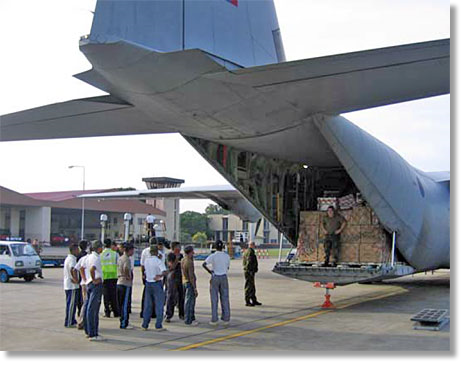
To give you some idea of the scale of the operations at Colombo airport, on the 28 Dec 04 over 280 tonnes of relief freight was delivered by civilian air transport. This figure increased every day and on the 6 Jan 05 over 780 tonnes arrived. All this was passing through one unfinished building. A number of options for RAF assets were explored, including shuttling fuel from Singapore and field cookers from Deli, however, there seemed to be no requirement for tactical airlift in the Sri Lankan relief aid effort and the UKMAMS team was recalled to the UK on the 8 Jan 05.
